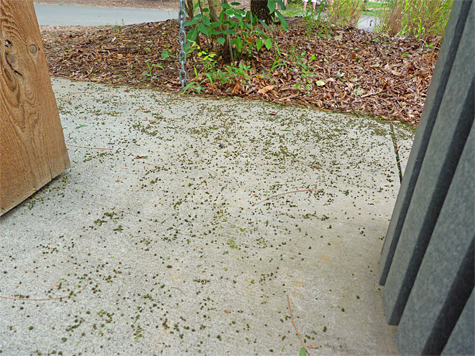
One could hardly miss the frass surrounding the willow oak tree next to the vending area in Catch the Wind, it was everywhere. Of course, if you don’t know what frass is then you may not have noticed it, thinking it mulch that had been blown onto the sidewalk by the wind.
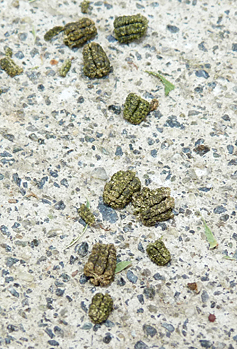
Well, it wasn’t mulch, it was caterpillar poop, or frass, a sure sign that there are caterpillars above. With this much frass there must be many caterpillars feeding above. There were. Hundreds of Orange-striped, or Orange-tipped, Oakworm (Anisota senatoria) caterpillars were munching away on the young willow oak tree.
Orange-striped Oakworm caterpillars are the larvae of the Orange-striped Oakworm moth. The moths lay hundreds of eggs on the undersides of an oak tree’s leaves, and the larvae that hatch from those eggs can defoliate a small tree rapidly and thoroughly. According to what I’ve read about them, the defoliation doesn’t seem to kill or do lasting harm to the tree since it often happens late in the season. However, this seems a bit early in the season for this group of orange-stripeds to be munching away.
The tree in question has not been totaly defoliated though, and I’m sure it will survive. A look at the tree this morning (7/26) revealed no caterpillars, they had all eaten their fill, crawled out of the tree and those that hadn’t been stepped on or run over have dug into the ground where they will remain until next year.
Here are some photos of the caterpillars.
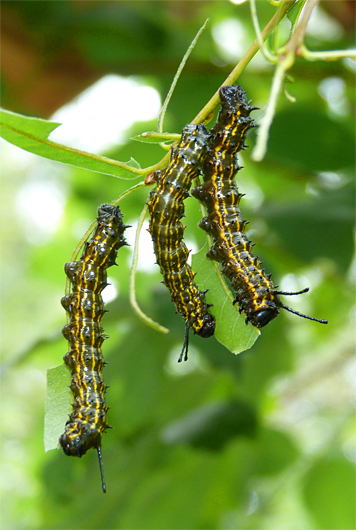
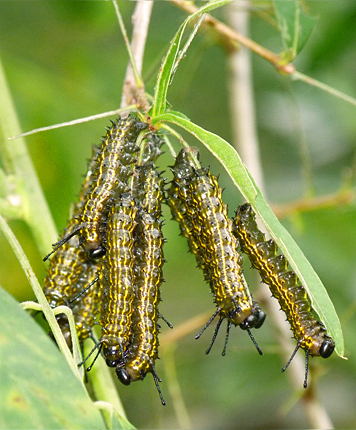
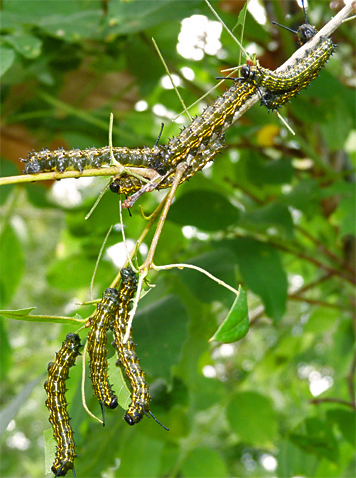
I most often see these caterpillars on willow oak, but other oaks are also used. And, its always a young oak tree that I see them on, but that may simply be a result of my not noticing them higher up on the mature oaks.
I’ve never actively sought out these caterpillars so if they’re not on the ground or somewhere close to eye level I probably wouldn’t see them at all. But as mentioned, frass on the grass (or sidewalk) is a dead giveaway, and a clear sign to look up.
Hi Greg new to the area and have a home 2 years in and my tree in the front yard is totally infested with these. My first clue was the driveways is totally covered in poo and then you look up into the low branches of the tree and they are everywhere. With a glance i see 20-25 on each branch. So my question is should I do anything, i’m about to go to home depot and get some spray. but B any insight on how to clean the poo from the driveway.
thank you wish I could post a picture it is truly amazing to see all the poo on the driveway.
The oak worms are in a tree that hangs over my pool. It has been covered with Frass. I am not sure how to stop this or who to call. Any suggestions would be helpful.
The caterpillars don’t usually do permanent damage to the tree since it’s so late in the season. That, however, is little consolation for your frass in the pool problem. I don’t think there’s much you can do at this time. I would consider cutting back the tree in the off season so it doesn’t hang over the pool. Good luck.
Yes, I found a baby caterpillar (bright green larvae) on a leaf eating away. I didn’t see any other caterpillars. How do I stop them from getting on the tree, or can I? Any assistance is most appreciated. I have two young Willow Oak trees!
The caterpillars were placed on the tree by an adult female moth in the form of eggs. Unless you get to the moth first (or the eggs) it’d be difficult to keep the caterpillars from getting onto the tree. If you actually do have oakworms, the damage to the tree is minimal since the caterpillars mature late in the season when most of the tree’s growth has already taken place. The trees will most likely survive, though it may not appear so from the near defoliation of the tree through the work of the caterpillars. Good luck.
Hi Greg, we have had theese caterpillers on our tree this year. The tree is a common type of willow that grows on river banks. We are in Brighton Sussex, UK. They are coming off the tree and going up walls? where are they going please tell. Where do they usually go and do they pupate now? Do they sting? They seem to walk a long way?? Kind regards and await your email.
Julie Warburton.
Are you telling me that you have Orange-stripped Oakworms (Anisota senatoria) in the UK? If so, I wasn’t aware of it. Please enlighten me.
Our oakworms crawl off and pupate underground. And you’re correct, they may wander some distance before finding the right location. They remain underground for about nine months emerging the following summer.
Orange-stripped Oakworms do not sting. I’ve picked them up many times. However, I’m not exactly sure what species you have where you live, so I’d take care on picking up any caterpillar without knowing ahead of time whether or not they do sting. Some species can give you a powerful jolt!
Thanks,
After going out and taking more pictures and finding eggs on the underside of what I think is a red oak tree I found that our catepillars are called Pink striped oakworms. Oxley Nature Center, Tulsa, OK.
I was out our nature center here in Tulsa, OK today called Oxley Nature Center and I saw what appeared to me to be the same catepillar that you are experiencing in your area. Our dragonflies are certainly thriving here as well. Enjoyed your site. I am currently locating sites to help in identifying dragonflies and your site came up. Thanks for sharing!
That’s great!
As far as the dragonflies, I checked out your check list and you have just over twice the species of odes that I’ve been able to log here at the Museum of LIfe + Science. I’ve positively ID’d about 36 species over the five years that I’ve been here. Having checked out the map of Oxley, and also the satellite image of your site, I can see you have a diverse source for the odes, streams, a pond, a lake, and Bird Creek, a good sized stream on the property. Looks like a nice place to spend your days hunting odes.
Thanks,